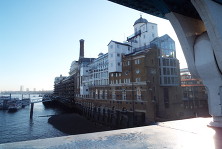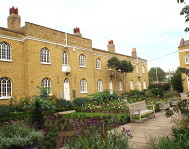








Guinness Trust buildings in Snowsfields, Bermondsey and Kennington Park Road
The photos above show two Guinness Trust developments in Southwark. On the left Snowsfields in Bermondsey, built in 1897, and on the right the estate in Kennington Park Road built in 1921. The Guinness Trust built a total of four estates in Southwark, the two shown above, one in Brandon Street that was demolished completely, and one in Page’s Walk that was demolished and then rebuilt to create a more modern Guinness Trust estate in the 1970s.
On 20 November 1889 the Times announced “a most splendid act of private munificence” by Sir Edward Guinness, head of the brewing family and later to become Lord Iveagh. He had placed in the hands of three trustees the sum of £250,000 for the “erection of dwellings for the labouring poor.” £200,000 was to be spent on housing in London and the remaining £50,000 in Dublin. He followed in the footsteps of wealthy philanthropists George Peabody and Sir Sydney Waterlow of the Improved Industrial Dwelling Company in providing housing for the labouring classes. However a recent Royal Commission Report of 1884 had found that the Peabody Trust and the IIDC and other similar organisations had done very little for the poorest class among whom overcrowding had been and still was at its worst with “monstrous” results – moral, physical and economical. The Times reported that the new dwellings were mainly occupied by a class above that for which they were intended and had become homes to clerks and skilled artisans. “In some cases the clearances effected in order to provide improved dwellings have actually increased the overcrowding in the immediate neighbourhood, by driving the inhabitants of a few dismantled rookeries into those left untouched.”
In contrast Sir Edward Guinness in creating the Guinness Trust intended to provide “clean and healthy homes for people somewhat poorer than those who at present avail themselves of the existing artisans’ dwellings.” Guinness Trust tenements would be let at such rents that would “place them within the reach of the poorest of the labouring population.” Any profit would be reinvested to build more housing.
The first Guinness Trust estate opened in Brandon Street, Walworth in 1891. A row of small terraced houses facing onto Brandon Street and a parchment factory behind were demolished to make way for the new five-storey blocks. There was a total of 190 one-, two- and three-roomed tenements with no running water
inside the apartments but shared sinks and w.c.s on the landings. Windows were fitted with Venetian blinds and the rooms were said to be well equipped with cupboards of every kind. There was no electricity in the flats, lighting was by gas, and tenants were able to purchase coal in small quantities at a cheaper rate. The estate had a common room, or club with a piano, board games, newspapers and other means of recreation. Refreshments were available in the club in the evenings and once a week there was a specially organized entertainment such as a concert, a popular lecture or a dramatic performance. There was also a nursery, instigated by Lady Iveagh, where children under five were cared for while their mothers were at work.
The Guinness Trust housing in Page’s Walk, Bermondsey, built on the site where formerly a carpet and floor cloth factory had been situated, was completed in 1895. There were a total of 457 tenements in four six-storey blocks and, like Brandon Street, there was no electricity or running water within the apartments with communal sinks and w.c.s on shared landings. Baths and laundry facilities were housed in separate blocks. A revealing first hand account of living on the Page’s Walk estate in the 1950s can be found on the Guinness Trust history website which was created to celebrate 125 years of the Guinness Trust.
The second Guinness Trust estate in Bermondsey was opened in 1897 in Snowsfields comprising 355 tenements in five-storey blocks, partially paid for by the South Eastern Railway Company. The investigator for the Charles Booth Poverty Maps reported the area had been metamorphosed with the demolition of the network of courts and the erection of the Guinness Trust blocks. The blocks were full and management of them appeared excellent.
Plans to build the estate in Kennington Park Road were finalised in 1913 but delayed because of the outbreak of World War I. Building eventually got under way in 1921 on land cleared by the demolition of a row of houses called Canterbury Row. The original designs were similar to other Guinness Trust blocks of that time but were built to meet the changing demand for lower blocks and self-contained apartments. The blocks were only four-storeys high and included bathrooms within the individual flats. It was the first Guinness Trust development to receive a government subsidy.
The Guinness Trust buildings in Kennington Park Road and Snowsfields were modernised between the 1950s and 1970s and still provide low cost housing.
Electricity was introduced to common areas of the estate in Brandon Street together with other renovations in the 1950s but these first Guinness Trust buildings were sold to Southwark Council in 1967 and demolished to make way for the Heygate Estate. Now the Heygate Estate has been demolished, Guinness has returned to Walworth and are building new blocks overlooking Nursery Row Park, just around the corner from Brandon Street in Stead Street. There will be a total of 140 new homes, 84 of which will be let at social rents to local people.
The estate at Page’s Walk underwent some modernisation in the early 1960s but the whole estate was demolished in the 1970s to make way for a new, modern estate. The Guinness Trust, now known as the Guinness Partnership, now own and manage 60,000 homes throughout the country with a total of 120,000 residents.
Web discoveries
- UK Casino Not On Gamstop
- UK Casino Not On Gamstop
- Non Gamstop Casino
- Casinos Not On Gamstop
- Non Gamstop Casinos
- Non Gamstop Casinos
- Non Gamstop Casino
- Casino Sites Not On Gamstop
- Slots Not On Gamstop
- Casinos Not On Gamstop
- UK Betting Sites Not On Gamstop
- UK Casino Not On Gamstop
- Best Non Gamstop Casinos
- Betting Sites
- Non Gamstop Casino Sites UK
- Best Non Gamstop Casinos
- Non Gamstop Casino
- Casinos Not On Gamstop
- Non Gamstop Casino Sites UK